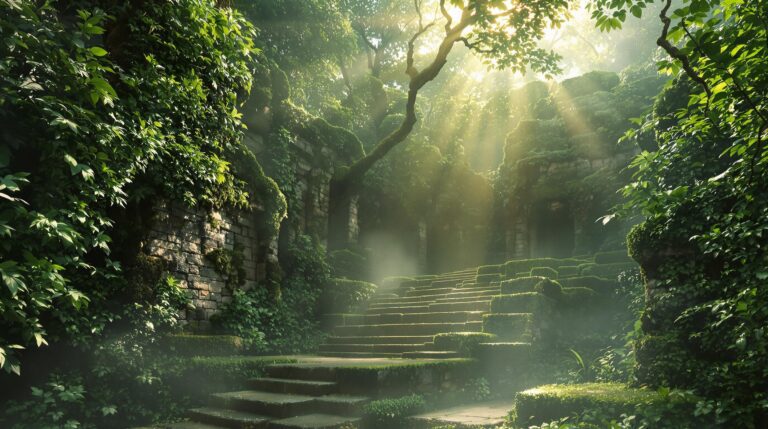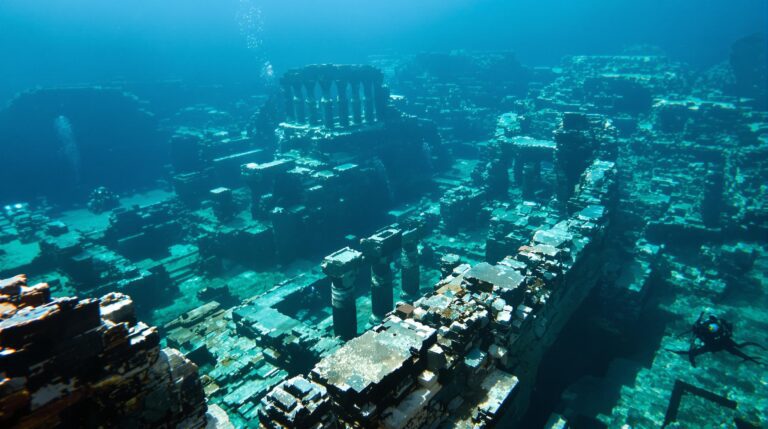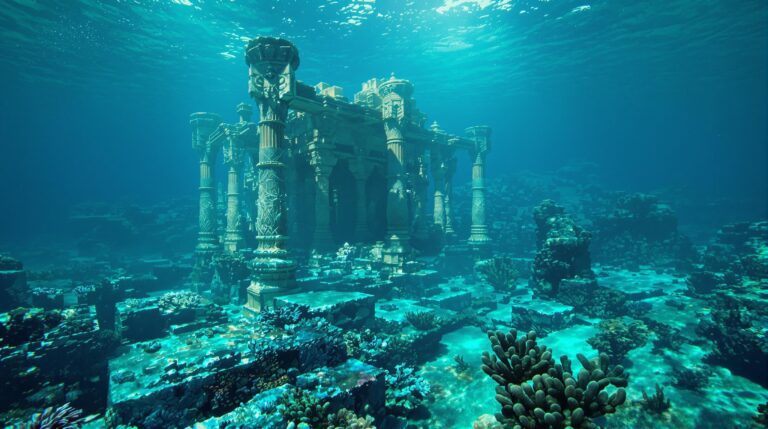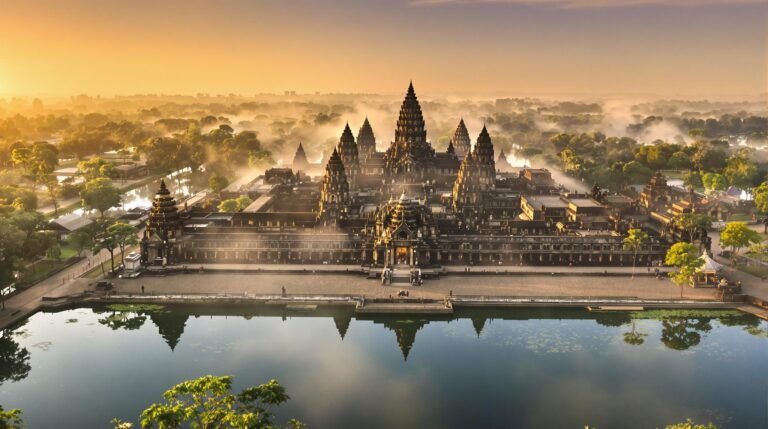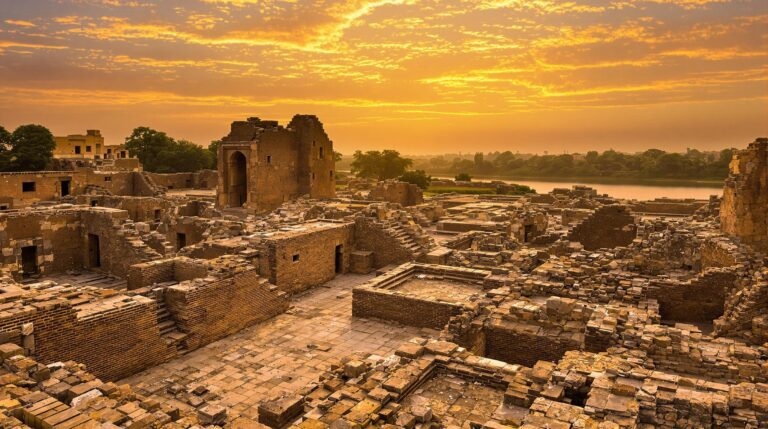Xanadu: Legendary Capital of Kublai Khan
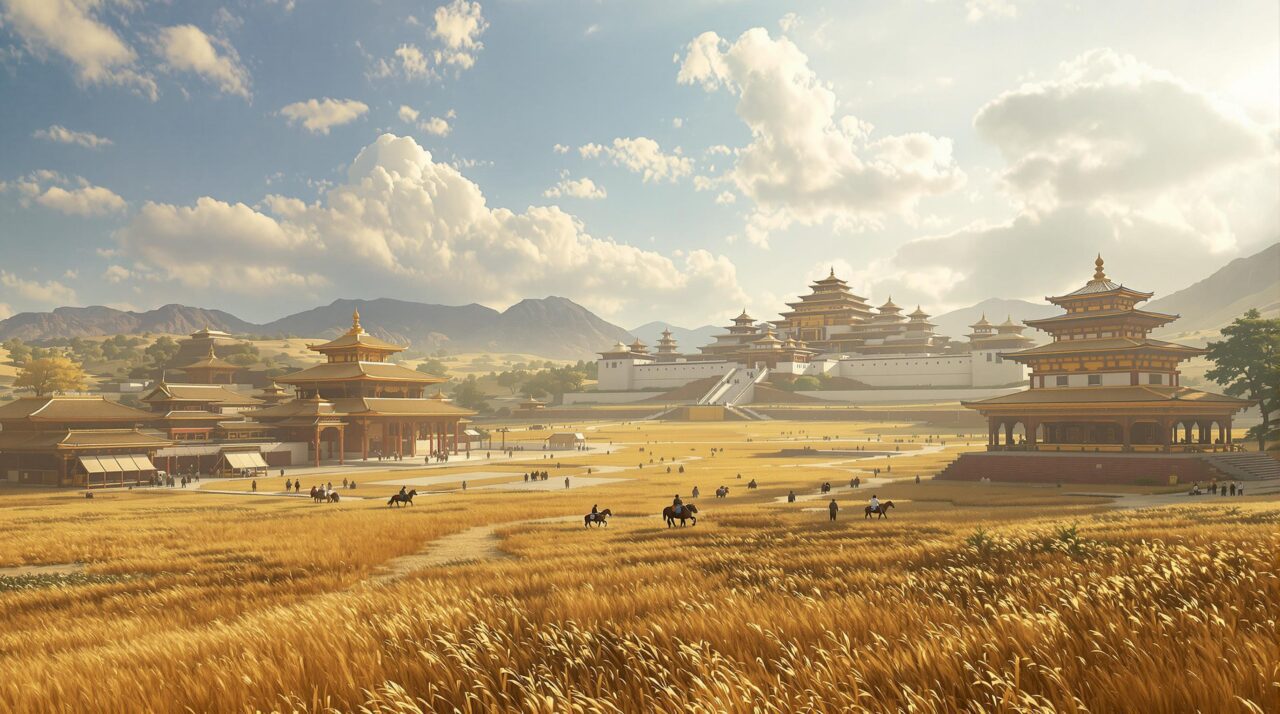
Nestled between the sweeping plains and winding rivers, Xanadu emerged as a symbol of Kublai Khan’s vision.
Its architectural marvels, harmonizing yurt and pagoda, whispered tales of cultural fusion.
Lively marketplaces thrived, echoing with the laughter of traders and scholars.
Yet, as political tides shifted, the city’s grandeur began to wane. What secrets still linger in the shadows of its fading splendor? The story of Xanadu invites exploration beyond mere history.
Summary of Key Points
Hide- Xanadu was envisioned by Kublai Khan as a symbol of opulence and a harmonious retreat, blending nature with architectural magnificence.
- The city featured a cultural fusion of Mongolian and Chinese traditions, showcased through lively marketplaces and diverse culinary experiences.
- Architectural achievements in Xanadu included palatial structures and meticulously designed gardens, reflecting a blend of Eastern and Western artistic influences.
- Kublai Khan's governance promoted innovation and collaboration among advisors from various cultural backgrounds, fostering a flourishing era of enlightenment.
- Historical accounts by Marco Polo and others highlight Xanadu's grandeur, though skepticism surrounds the accuracy of these vivid descriptions.
The Founding of Xanadu
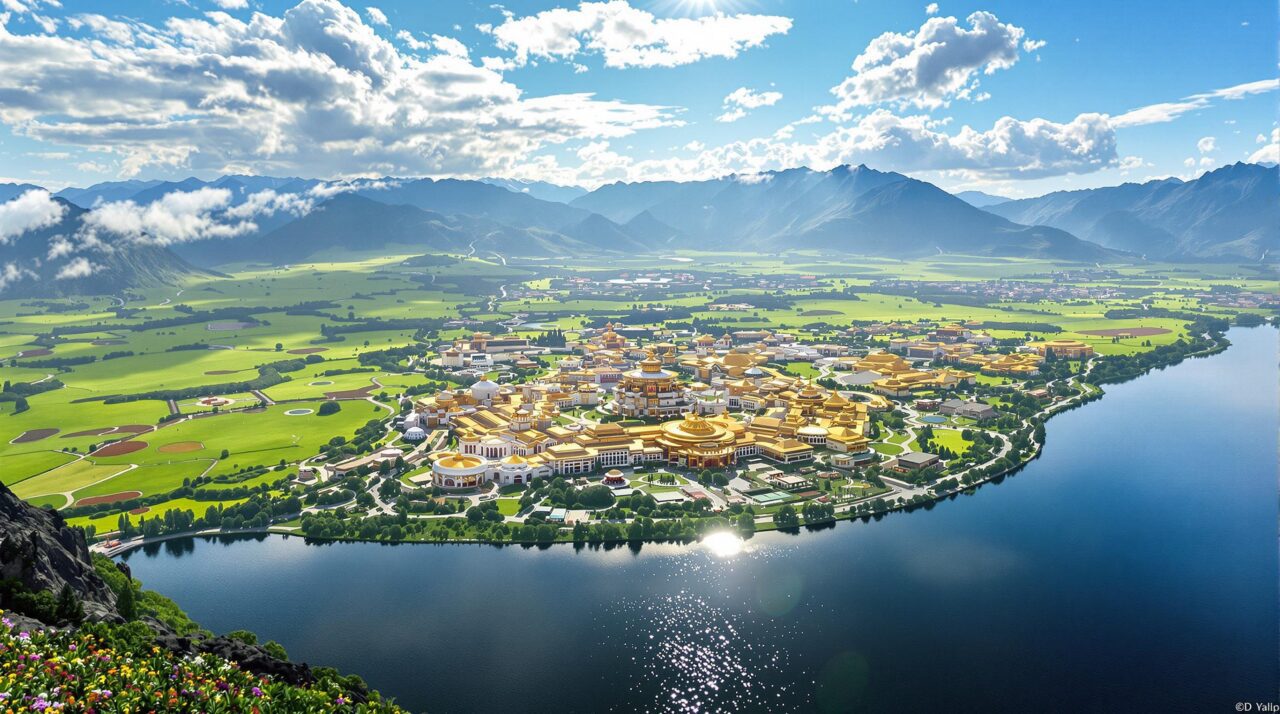
In the heart of the Mongolian steppes, Kublai Khan envisioned Xanadu not merely as a city, but as a shimmering jewel of opulence and power.
Its strategic location, nestled between the vastness of the plains and the abundant waters of the rivers, served to reflect the grandeur of a ruler intent on uniting his vast empire.
This site, chosen with meticulous care, would become a symbol of the Mongol spirit, merging nature’s beauty with the architectural magnificence of human ambition.
Kublai Khan’s Vision for a Royal Capital
In the vast expanse of the Mongolian steppes, Kublai Khan envisioned Xanadu not merely as a capital but as a harmonious tapestry woven from the threads of Mongolian customs and the refined elegance of Chinese civilization.
This ambitious melding of cultures transformed the landscape into a lively oasis, where the nomadic spirit of the steppes danced alongside the grandeur of imperial architecture.
Here, in this legendary city, the echoes of two worlds converged, creating a unique identity that would resonate through history.
Merging Mongolian Customs with Chinese Influence
As Kublai Khan envisioned his royal capital, Xanadu emerged as a striking tapestry woven from Mongolian traditions and Chinese influences, reflecting the syncretic culture of his empire.
This grand vision manifested in:
- Lively marketplaces filled with both Mongolian and Chinese goods
- Architectural marvels blending yurt and pagoda
- Festivals celebrating diverse heritages
- Culinary fusions tantalizing the senses.
Choosing a Strategic Location
In the sweeping embrace of the Mongolian grasslands, Kublai Khan envisioned Xanadu not merely as a city, but as a harmonious retreat into nature’s lush splendor.
This strategic location, with its vast expanses and gentle breezes, promised respite from the rigors of rule and a sanctuary for the imperial court.
Here, amidst the undulating hills and lively flora, the foundations of a legendary capital were meticulously laid, aligning power with the serene rhythms of the earth.
Grasslands as the Perfect Summer Retreat
The vast, undulating grasslands surrounding Xanadu offered a breathtaking canvas of emerald waves, a striking contrast to the harsh rigidity of the steppes.
This idyllic locale served as a perfect summer retreat, characterized by:
- Gentle breezes whispering through the grasses
- Lively wildflowers painting the landscape
- Abundant wildlife roaming freely
- A serene atmosphere fostering communion with nature
Such beauty beckoned to the spirit of wanderers.
Architectural Splendor in the Heart of the Steppe
In the heart of the vast steppe, Xanadu emerged as a breathtaking tapestry of palatial grandeur and exquisite pavilions, each structure a tribute to Kublai Khan’s vision.
Surrounded by meticulously designed gardens, these architectural marvels seamlessly blended diverse artistic influences, weaving together elements from the East and West into a harmonious whole.
This convergence of styles not only reflected the empire’s vast reach but also offered a glimpse into the cultural richness that defined one of history’s most legendary capitals.
Palaces, Pavilions, and Surrounding Gardens
In the heart of the steppe, Xanadu’s architectural marvels rise like mirages, each palace and pavilion a demonstration of Mongol grandeur.
Their bold design elements, adorned with intricate carvings and lively colors, echo the empire’s rich cultural tapestry.
Surrounded by lush gardens, these structures invite contemplation, beckoning visitors to explore the harmonious blend of nature and human ingenuity.
Bold Design Elements Showcasing Mongol Grandeur
Amidst the vast expanses of the Mongolian steppe, Xanadu emerges as a breathtaking embodiment of Kublai Khan’s vision, where bold design elements intertwine with nature’s grandeur.
- Towering eaves that mimic the curve of the horizon
- Intricate murals depicting the celestial sky
- Expansive gardens echoing the rhythm of the seasons
- Majestic pavilions that invite contemplation and serenity
Integration of Diverse Artistic Styles
In the majestic domain of Xanadu, architectural ingenuity blossomed through the confluence of diverse artistic styles, each echoing the whispers of far-off lands along the Silk Road.
The intricate building techniques, woven together with lively mosaics and ornate woodwork, revealed the colorful fabric of cultural exchanges that defined Kublai Khan’s empire.
This harmonious fusion not only adorned the landscape but also embodied a celebration of human creativity, standing as a tribute to the era’s dynamic spirit.
Silk Road Influences in Building Techniques
As the winds of the Silk Road swept through the vast steppes, they carried with them not only traders and goods but also an exchange of architectural ingenuity that would shape the legendary capital of Kublai Khan.
- Fusion of Eastern and Western styles
- Intricate woodwork inspired by Chinese artisans
- Stalwart stone fortifications from Central Asia
- Lively mosaics reflecting Persian influence
Life and Culture at the Summer Residence
At the heart of Xanadu, life blossomed amidst a tapestry of lively festivals and intricate diplomatic gatherings, where the air pulsed with the mingling of cultures.
Kublai Khan’s administration, a masterful blend of Mongolian tradition and foreign influence, orchestrated these events to showcase the splendor of his domain and to forge alliances.
The summer residence, with its lush landscapes and opulent pavilions, served as a stage where power and artistry danced in harmonious celebration.
Festivals and Diplomatic Gatherings
In the opulent surroundings of Xanadu, a tapestry of cultures unfolded during grand festivals and diplomatic gatherings, where scholars, traders, and nobles converged in a display of unity and ambition.
Rich silks and fragrant spices filled the air, while lively discussions sparked intellectual fervor, weaving together the threads of commerce and diplomacy.
Each gathering not only celebrated Kublai Khan’s reign but also served as a crucible for ideas, alliances, and the very essence of Mongolian life and culture.
Scholars, Traders, and Nobles in Attendance
Amidst the sprawling landscapes of Xanadu, a lively tapestry of culture and intellect unfolded, attracting scholars, traders, and nobles from far and wide.
They converged to witness:
- Rich exchanges of ideas and goods
- Dynamic discussions illuminating philosophy and science
- Diplomatic negotiations fostering unity
- Celebrations infused with art and music
In these moments, Xanadu became a crucible for enlightenment and camaraderie, echoing the era’s quest for freedom.
Kublai Khan’s Administration
In the opulent halls of Xanadu, Kublai Khan orchestrated a governance marked by the lively interplay of diverse cultures and ideas.
His court, a tapestry woven from the threads of Mongol, Chinese, and Persian influences, thrived as a crucible of innovation and diplomacy.
Within this cosmopolitan enclave, the Khan’s administration not only reflected his imperial might but also cultivated a unique harmony that resonated through the very fabric of his domain.
Governance Amidst a Cosmopolitan Court
While the opulent halls of Xanadu resonated with the whispers of diverse cultures, Kublai Khan’s administration thrived within a governance structure that mirrored the very cosmopolitan essence of his summer residence.
- A tapestry of traditions interwoven
- Diplomats from distant lands
- Advisors skilled in multiple disciplines
- Policies fostering unity and innovation
Such a melting pot of ideas propelled an era marked by enlightenment and cultural flourishing.
Marco Polo’s Fascination and Record
Marco Polo, the intrepid Venetian traveler, beheld the grandeur of Xanadu through a lens of wonder and incredulity, capturing its splendor with vivid descriptions that danced on the page.
His accounts, rich with exotic imagery and enthralling detail, beckon readers to question the very fabric of historical truth, leaving a tantalizing ambiguity that shadows his journey.
As whispers of skepticism arise regarding the accuracy of his observations, the allure of Polo’s tale continues to enchant, inviting exploration into the heart of a legendary empire.
Observations from a European Traveler
Marco Polo’s chronicles of Xanadu paint a vivid tapestry of opulence and mystery that captivated the imaginations of European audiences.
His detailed accounts, woven with threads of wonder and incredulity, offered glimpses into a domain where nature and artistry coalesced under the reign of Kublai Khan.
Each word served not merely as a description, but as an invitation to explore a world brimming with exotic marvels and uncharted territories.
Accounts That Sparked Widespread Curiosity
Few accounts from the annals of history have ignited the imagination quite like the tales spun by a Venetian traveler who journeyed to the far reaches of the Mongol Empire.
His observations painted a vivid tapestry of:
- Opulent feasts beyond imagining
- Majestic landscapes whispering secrets
- Cultures entwined in lively harmony
- The enigmatic grandeur of Xanadu
These narratives beckoned the curious, shaping perceptions of an exotic world.
Questions About Historical Accuracy
Amidst the shimmering tales spun by Marco Polo lies a tapestry woven with threads of skepticism and intrigue.
Scholars engage in a vigorous dance of debate, questioning the authenticity of Polo’s experiences as he traversed the vast landscapes of Kublai Khan’s empire.
Was the traveler a mere chronicler of grandiose fantasies, or did his vivid accounts hold a mirror to the dazzling reality of a world unseen?
Scholarly Debates on Polo’s True Experiences
The enigmatic figure of Marco Polo has long captivated scholars and historians alike, inciting fervent debates about the veracity of his accounts from the court of Kublai Khan.
- The authenticity of his travels is questioned.
- Critics argue embellishments cloud his narratives.
- Supporters defend his keen observations.
- Manuscripts reveal contradictions, challenging perceptions.
Thus, the quest for truth within his tales continues, echoing through time.
The City’s Decline and Legacy
As the winds of political change swept across the Mongolian steppes, Xanadu’s once-vibrant streets fell silent, its opulent palaces succumbing to the relentless grasp of time.
Archaeological endeavors have since unearthed remnants of this legendary city, revealing layers of history that whisper tales of grandeur and decay.
The legacy of Xanadu, though diminished, continues to captivate the imagination, beckoning scholars and dreamers alike to ponder its enigmatic past.
Decline After Changing Political Winds
As the tides of military power shifted, Xanadu, once a lively jewel of Kublai Khan’s empire, faced an inevitable decline, its grandeur fading into whispers of history.
Abandoned by those who once reveled in its opulence, the city became a mere shadow of its former self, the echoes of its lively marketplaces replaced by the haunting silence of desolation.
This transformation, steeped in the complexities of political upheaval, left a legacy that straddled the domains of myth and memory, a reflection of the fragility of even the mightiest capitals.
Military Shifts and Abandonment of the Capital
Amidst the shifting sands of political power, Xanadu found itself ensnared in a web of military upheaval that heralded its decline.
The once-magnificent capital crumbled under the weight of change, as:
- Conflicts erupted among factions
- Troops dispersed, abandoning loyalty
- Resources dwindled, lost to strife
- The lively culture faded, like distant echoes
Thus, Xanadu’s legacy dimmed, overshadowed by the tumult of its times.
Archaeological Research and Preservation
Amidst the whispering winds that carry tales of opulence and decline, the ruins of Xanadu beckon modern archaeologists with secrets waiting to be unearthed.
Ongoing research efforts, fueled by a passionate desire to safeguard this legendary site, illuminate the fragile remnants of a bygone era, where grand palaces once echoed with the laughter of Kublai Khan’s court.
As preservationists tread carefully among the crumbling stones, each brushstroke of excavation reveals a tapestry of history, urging contemporary society to honor and protect the legacy of this mythical capital.
Ongoing Efforts to Study and Protect the Ruins
Numerous scholars and conservationists are now dedicating their efforts to unraveling the mysteries of Xanadu, the storied capital of Kublai Khan.
Their pursuits illuminate the ethereal remnants of this once-majestic city:
- Excavating ancient structures and artifacts
- Utilizing advanced technologies for preservation
- Documenting cultural narratives to enhance understanding
- Collaborating with local communities to foster stewardship
These endeavors breathe life into Xanadu’s legacy, safeguarding it for future generations.
Wrapping Up
In the fading echoes of Xanadu, where golden dreams once danced under the vast Mongolian sky, the spirit of Kublai Khan’s vision endures.
Though time has weathered its opulence and the lively marketplaces now lie silent, the city remains a shimmering tapestry woven from the threads of cultural confluence and intellectual brilliance.
Xanadu, a poignant reminder of humanity’s capacity for grandeur, continues to inspire a longing for unity and innovation, beckoning future generations to remember its enchanting legacy.
